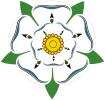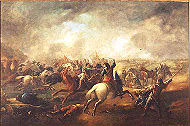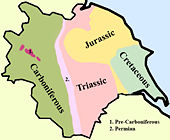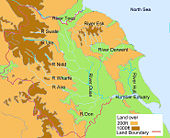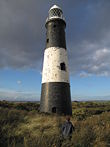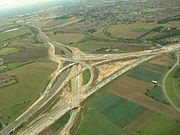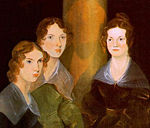Yorkshire
2008/9 Schools Wikipedia Selection. Related subjects: Geography of Great Britain
| Yorkshire | |
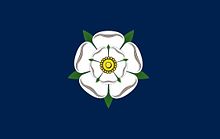 Flag of Yorkshire |
|
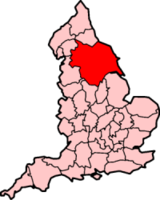 Yorkshire within England in 1881 |
|
| Geography | |
| 1831 area | 3,669,510 acres (14,850 km²) |
| 1901 area | 3,883,979 acres (15,718 km²) |
| 1991 area | 2,941,247 acres (11,903 km²) |
| HQ | York |
| Chapman code | YKS |
| History | |
| Origin | Kingdom of Jórvík |
| Created | In antiquity |
| Succeeded by | Various |
| Demography | |
|---|---|
| 1831 population - 1831 density |
1,371,359 0.37/acre |
| 1901 population - 1901 density |
3,512,838 0.9/acre |
| 1991 population - 1991 density |
3,978,484 1.35/acre |
| Subdivisions | |
| Type | Ridings |
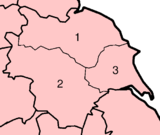 |
|
| Units | 1 North • 2 West • 3 East |
Yorkshire is a historic county of northern England and the largest in Great Britain. Although Yorkshire is not a current unit of civil administration, it is included in the name of a number of contemporary subdivisions such as Yorkshire and the Humber. The name is familiar and well-understood across the United Kingdom and is in common use.
Throughout much of history, Yorkshire has played a prominent role in Great Britain. The Brigantes, who were the largest Celtic Briton tribe held it as their heartland. The Romans made York (from which the county derives its name) one of the two capitals of all Roman Britain. The area was an independent Viking kingdom known as Jórvík for around a century, before being taken by England. Most of the modern day large cities were founded during the Norman period.
The county covered just under 6,000 square miles (15,000 km²) in 1831 and the modern day Yorkshire and the Humber region has a population of around five million. Yorkshire is widely considered to be the greenest area in England, due to both the vast rural countryside of the Yorkshire Dales, North York Moors and some of the major cities, this has led to Yorkshire being nicknamed God's Own County.
The emblem of Yorkshire is the White Rose of the House of York, the most common flag representative of Yorkshire is the White Rose on a dark blue background. Yorkshire Day is held on August 1, a celebration of the general culture of Yorkshire, ranging from its history to its very own language.
History
Celtic tribes
The original inhabitants of Yorkshire were the Celts, coming from two separate tribes. The Brigantes, who probably came over from the Alps or Gallaecia, controlled territory which included all of the North Riding of Yorkshire and the West Riding of Yorkshire, the tribe controlled most of Northern England and more territory than any other Celtic tribe in England.
The Brigantes made the area of Yorkshire their heartland, this is evident in that Isurium Brigantum (now known as Aldborough) was made the capital town of their entire territory; in fact six of the nine Brigantian poleis described by Claudius Ptolemaeus in the Geographia fall within the historic county. The second tribe were the Parisii who controlled the exact area of the East Riding of Yorkshire, they were thought to have been related to the Parisii of Lutetia Parisiorum, Gaul (known today as Paris, France).
The Roman conquest of Britain began in 43 AD, however the Brigantes continued control of their kingdom as a client state of Rome for an extended period, accepted under the reign of Brigantian monarchs Cartimandua and Venutius. The situation suited both the Romans and the Brigantes initially, who themselves were known as the most militant tribe in Britain.
Roman Yorkshire
Queen Cartimandua left her husband for Vellocatus, setting off a chain of events which would change the ownership of the Yorkshire area. Cartimandua, due to her good relationship with the Romans was able to keep control of the kingdom, however her former husband staged rebellions against her and her Roman allies. At the second attempt Venutius took back his kingdom, but the Romans under general Petillius Cerialis conquered the Brigantes in 71 AD.
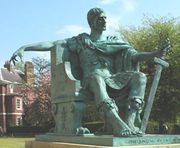
Under Roman rule, the high profile of the area continued; the fortified city of Eboracum (now known as York) was named as capital of Britannia Inferior and joint-capital of all Roman Britain. For the two years before the death of Emperor Septimus Severus, the entire Roman Empire was run from Eboracum by him. A second Emperor Constantius Chlorus died in Yorkshire during a visit in 306 AD, this saw his son Constantine the Great proclaimed Emperor in the city; he would become renowned due to his contributions to Christianity.
In the early 400s the Roman rule ceased with the withdrawal of the last active Roman troops, by this stage the Empire was in heavy decline. However, during the three and a half centuries of Roman rule in Yorkshire they had introduced much to help forward civilisation there, such as; sanitation, irrigation, education, roads, public libraries, cement, bricks, heated baths, coins, art, literature, law, wine, the calendar, glass, shops, public order, cats, various fruits and vegetables (carrots, turnips, apples, peas, cabbage, pears, grapes) and more.
Second Celtic period and Angles
After the Romans left, small Celtic kingdoms built up in Yorkshire; the Kingdom of Ebrauc around York and more notably the Kingdom of Elmet around West Yorkshire. The Elmet in particular managed to hold out with their Celtic kingdom against the invading Angles for a century and a half, ensuring that the Anglian kingdoms of Mercia and Northumbria on either side developed separately. Eventually the Elmet succumbed and became part of the Anglian kingdom of Deira.
It should be noted that, although this period is called the Anglo-Saxon period, it was the Angles (from Angeln) who conquered the North, while the Saxons (from Nordalbingia) conquered the South. Under Aethelfrith Deira merged with another Anglian kingdom of Bernicia in the early 600s, to form the Kingdom of Northumbria. At its greatest extent, Northumbria stretched from the Irish Sea to the North Sea and from Edinburgh down to Hallamshire in South Yorkshire.
Kingdom of Jórvík
An army of Danish Vikings invaded Northumbrian territory in 886 AD, with what was named by their enemies as the " Great Heathen Army". The Danes took what is modern day York and renamed it as Jórvík, making it their new capital city of a kingdom under the same name; the area which they took as their kingdom was Southern Northumbria (Yorkshire).
The Danes went on to conquer a large area of England which afterwards became known as the Danelaw, but whereas most of the Danelaw was still English land, albeit in submission to Viking overlords, it was in the Kingdom of Jórvík founded by Halfdan Ragnarsson, that the only truly Viking territory on mainland Britain was established. Although it was founded by Danes, the kingdom was passed onto Norwegian kings. Through the Vikings evolving trade, Jórvík was able to trade with the British Isles, North-West Europe, the Mediterranean and the Middle East.
Eric Bloodaxe, who was the last independent Viking king of Jórvík is a particularly noted figure in history. After around 100 years of a Norse-Yorkshire kingdom, the Kingdom of Wessex gained control of Yorkshire and the North in general, placing Yorkshire within Northumbria again - which was now an almost-independent earldom, rather than a separate kingdom. The Wessex Kings of England were reputed to have respected the Norse customs in Yorkshire and left law-making in the hands of the local aristocracy.
Norman conquest
In the weeks immediately leading up to the Battle of Hastings in 1066 AD, Harold II of England was distracted by events in Yorkshire; his brother Tostig and Harold Hardrada King of Norway were attempting a take over bid in the North, they had already won the Battle of Fulford. The King of England marched North and the two armies met at the Battle of Stamford Bridge, Tostig and Hardrada were both killed and their army was defeated decisively. However, Harold Godwinson was forced immediately to march his army back down to the South where William the Conqueror was landing. The King was defeated at Hastings and this led to the Norman conquest of England.
The people of the North rebelled again in September 1069 AD, this time against the Normans, enlisting Sweyn II of Denmark; they tried to take back York but the Normans burnt it before they could. What followed was the Harrying of the North ordered by William, from York to Durham all crops, domestic animals and farming tools were scorched. Many villages between the towns were burnt and many local Northerners were indiscriminantly murdered. During the winter that followed, whole families starved to death, thousands of peasants died of cold and hunger; Orderic Vitalis put the estimation at "more than 100,000" people from the North dead from hunger.
In the centuries following, many abbeys and priories were built in Yorkshire. The Norman landowners were keen to increase their revenues and established new towns such as Leeds, Hull, Sheffield, Barnsley, Doncaster, Scarborough and others. Of the towns founded before the conquest only York, Bridlington and Pocklington carried on at a prominent level.
The population of Yorkshire was booming, until it like the rest of Britain was hit by the Great Famine in the years between 1315 and 1322. In the early 1300s the people of Yorkshire also had to contest with the Battle of the Standard at Northallerton with the Scots, representing the Kingdom of England led by Archbishop Thurstan of York soldiers from Yorkshire defeated the more numerous Scots. The Black Death reached Yorkshire by 1349, killing around a third of the entire population.
Wars of the Roses
- For more information: House of York, Wars of the Roses
When King Richard II was overthrown, antagonism between the House of York and the House of Lancaster, both branches of the House of Plantagenet, began to emerge. Eventually the two houses fought in a series of civil wars (including battles at Wakefield and Towton) for the throne of England, the wars are commonly known as the Wars of the Roses. After a long violent struggle, King Henry VI of the House of Lancaster was deposed and imprisoned on 4 March 1461 by his Yorkist cousin and new King of England, Edward IV. Eight years later hostilities resumed, Edward was forced into exile to Burgundy by Richard Neville and turncoat John Neville as Lancaster's Henry VI was reinstated.
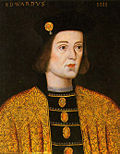
Edward would return though, landing in Ravenspurn he eventually went on to defeat the House of Lancaster, as Henry VI had no heirs, he was killed to strengthen Yorkist grip on the throne as Edward was restored as King of England. This was generally considered an end to the most significant hostilities, the rest of Edward's reign was peaceful. After Edward IV suddenly died and his 12 year old son Edward V was proclaimed as heir, a political storm erupted; a family named the Woodvilles had found themselves high up the political hierarchy and were in a position to influence the young Yorkist king.
Frictions had developed between Edward IV and the Woodvilles (the family of his wife Elizabeth Woodville) before his death and so Edward IV's brother Richard III, put the young king in the Tower of London along with his younger brother, they became known as the Princes in the Tower. Richard III argued that Elizabeth Woodville's marriage to Edward IV was illegal and thus the two boys were illegitimate, Parliament agreed and Richard was crowned King of England; he would prove to be the last Yorkist king. Henry Tudor of the House of Lancaster, then defeated and killed Richard at the Battle of Bosworth Field, he then became King Henry VII and married Elizabeth of York daughter of Yorkist Edward IV, ending the wars. The two roses were combined to form the Tudor Rose.
Saints, Civil War and textile industry
The wool industry being centred in West Yorkshire helped a revival in the 16th century. The textile industry in general helped Wakefield and Halifax grow. Changes were afoot outside of employment after Henry VIII closed some monasteries and so 1536 saw the Pilgrimage of Grace rebellion. Due to the Protestant Reformation wider England became a Protestant country, however some of the Catholic contingent in Yorkshire continued to practice their religion and those caught were executed during the reign of Elizabeth I, such as York woman Margaret Clitherow who was later canonised.
Yorkshire was on divided sides during the English Civil War, which started in 1642 between king and parliament; Hull famously shut the gates of the city on the king when he came to enter the city a few months before fighting began. York was the base for Cavalier royalist supporters, from there the royals captured Leeds and Wakefield only to have them recaptured a few months later. The royalists won the Battle of Adwalton Moor meaning they controlled Yorkshire (with the exception of Hull). From their base in Hull the Roundhead parliamentarians fought back, town by town re-taking Yorkshire until they had won the Battle of Marston Moor and with it control of all North of England.
Leeds and other wool industry centred towns continued to grow, along with Sheffield, Huddersfield and Hull, while coal mining first came into prominence in the West Riding of Yorkshire. Canals and turnpike roads were introduced in the late 1700s. In the following century the spa towns of Harrogate and Scarborough also flourished, due to people believing mineral water had curing properties.
Modern Yorkshire
The 19th century saw Yorkshire's continued growth, with the population growing and the Industrial Revolution continuing with prominent industries in coal, textile and steel (especially in Sheffield). However, despite the booming industry, living conditions declined in the industrial towns due to overcrowding, this saw bouts of cholera in both 1832 and 1848. Fortunately for the county, advances were made by the end of the century with the introduction of modern sewers and water supplies. Several Yorkshire railway networks were introduced as railways spread across the country to reach remote areas. County councils were created for the three ridings in 1889, but their area of control did not include the large towns, which became county boroughs, and included an increasing large part of the population.
During the Second World War, Yorkshire became an important base for RAF Bomber Command and brought the county into the cutting edge of the war. In the 1970s there were major reforms of local government throughout the United Kingdom. Some of the changes were unpopular, and controversially Yorkshire and its ridings lost status in 1974 as part of the Local Government Act 1972. With much receded borders, the official entity which currently contains most of the area of Yorkshire is the Yorkshire and the Humber region of England.
Physical geography
Historically, the northern boundary of Yorkshire was the River Tees, the eastern boundary was the North Sea coast and the southern boundary was the Humber Estuary and River Don and River Sheaf. The western boundary meandered along the western slopes of the Pennine Hills to again meet the River Tees. It is bordered by several other historic counties in the form of County Durham, Lincolnshire, Nottinghamshire, Derbyshire, Cheshire, Lancashire and Westmorland.
In Yorkshire there is a very close relationship between the major topographical areas and the geological period in which they were formed. The Pennine chain of Hills in the west is of Carboniferous origin. The central vale is Permo-Triassic. The North York Moors in the north-east of the county are Jurassic in age while the Yorkshire Wolds to the south east are Cretaceous chalk uplands.
The era of Yorkshire is drained by several rivers. In Western and central Yorkshire the many rivers empty their waters into the River Ouse which in turn reaches the North Sea via the Humber Estuary. The most northerly of the rivers in the Ouse system is the Swale, which drains Swaledale before passing through Richmond and meandering across the Vale of Mowbray. Next, draining Wensleydale, is the River Ure, which joins the Swale east of Boroughbridge. The River Nidd rises on the edge of the Yorkshire Dales National Park and flows along Nidderdale before reaching the Vale of York.
The Ouse is the name given to the river after its confluence with the Ure at Ouse Gill Beck. The River Wharfe, which drains Wharfedale, joins the Ouse upstream of Cawood. The Rivers Aire and Calder are more southerly contributors to the River Ouse and the most southerly Yorkshire tributary is the River Don, which flows northwards to join the main river at Goole. In the far north of the county the River Tees flows easteards through Teesdale and empties its waters into the North Sea downstream of Middlesbrough. The smaller River Esk flows from west to east at the northern foot of the North York Moors to reach the sea at Whitby.
The River Derwent rises on the North York Moors, flows south then westwards through the Vale of Pickering then turns south again to drain the eastern part of the Vale of York. It empties into the River Ouse at Barmby on the Marsh. To the east of the Yorkshire Wolds the River Hull flows southwards to join the Humber Estuary at Kingston upon Hull. The western Pennines are served by the River Ribble which drains westwards into the Irish Sea close to Lytham St Anne's.
Nature
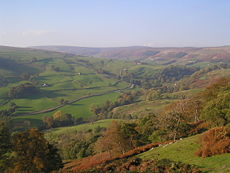
The countryside of Yorkshire is so renowned that it has earned the common nickname of God's Own County. In recent times, North Yorkshire has displaced Kent to take the title Garden of England.
Yorkshire has three national parks, in the form of the Peak District, North York Moors and the Yorkshire Dales. The coastal areas of Yorkshire are also renowned for their beauty, there are several nature reserves run by the Royal Society for the Protection of Birds on the coast, offering a chance to see the likes of the Northern Gannet and Atlantic Puffin.
Spurn Point a narrow, three mile (5 km) long sand spit featuring an abandoned lighthouse is also considered highly interesting from geomorphological perspective due to the cyclical nature of the feature. Whitby in North Yorkshire has been voted as the United Kingdom's best beach, due to its "postcard-perfect harbour".
Transport
The most prominent road in Yorkshire, historically known as the Great North Road, is in contemporary times known as the A1. The trunk road passes through the centre of the county and is the prime route from London to Edinburgh. Other important roads include the east serving A19 road which is also prominent for travelling up and down England. The M62 motorway crosses the county from east to west linking from Hull all towards Greater Manchester and Merseyside. The East Coast Main Line rail link between Scotland and London runs roughly parallel with the A1 through Yorkshire and the Trans Pennine rail link runs east to west joining Hull and Liverpool via Leeds.
Before the advent of rail transport, seaports of Hull and Whitby played an important role in transporting goods. Historically canals were used, including the Leeds and Liverpool Canal, which is the longest canal in England. In the modern day mainland Europe (the Netherlands and Belgium) can be reached from Hull via regular ferry services from P&O Ferries. Yorkshire also has air transport services in the form of the Leeds Bradford International Airport. The airport has experienced significant and rapid growth in both terminal size and passenger facilities since 1996 when improvements began until the present day. South Yorkshire is served by the Robin Hood Airport Doncaster Sheffield, based in Finningley.
Culture
The people of Yorkshire are immensely proud of both their county and its culture, embracing the popular nickname of God's Own County given to Yorkshire. It is sometimes suggested that Yorkshiremen identify more strongly with their county than they do with their country. The Yorkshire people have their own distinctive dialect known as Tyke, which some have argued is a fully fledged language in its own right. The county has also produced a unique set of Yorkshire colloquialisms, which are in use in the county. Among Yorkshire's unique traditions is the Long Sword dance, a traditional dance not found elsewhere in England. The most famous traditional song of Yorkshire is On Ilkla Moor Baht 'at ("On Ilkley Moor without a hat"), it is considered the unofficial anthem of the county.
Cuisine
The cuisine of Yorkshire and that of North England in general is known for using rich tasting ingredients, especially in regard to sweet dishes, which are widely affordable for the majority of people who live there, there are several dishes which originate from Yorkshire or are heavily associated with it.
Yorkshire pudding, created from batter, is by far the most well known element of Yorkshire food, it is commonly served with roast beef and vegetables to form part of the standard Sunday roast, which itself grew from the county. Other noted foods associated with the county includes; Yorkshire curd tart, a curd tart recipe with rosewater; Parkin, a sweet ginger cake which is different from standard ginger cakes in that it includes oatmeal and treacle and Wensleydale cheese, a cheese associated with Wensleydale.
The beverage ginger beer, flavoured with ginger came from Yorkshire and has existed since the mid 1700s. Liquorice sweet was first created in Yorkshire by George Dunhill from Pontefract, who in the 1760s thought to mix the liquorice plant with sugar. Leading on from this, Yorkshire and in particular the city of York played a prominent role in the confectionary industry, with chocolate factories or companies, such as Rowntree's, Terry's and Thorntons inventing many of Britain's most popular sweets.
Sport
Yorkshire has played a highly important role in the development of sports, some forms of which have gone on to have world wide notoriety. Sport holds a significant role in the overall modern day culture of the county, the main sports are football, cricket and rugby league. The counties cricket side Yorkshire County Cricket Club are the most successful in the County Championship, winning a grand total of 30 championship titles, 12 more than any other county. Some of the most highly regarded figures in the game are Yorkshiremen, amongst them Herbert Sutcliffe and Len Hutton.
Yorkshire is officially recognised by FIFA as the birth-place of club football, as Sheffield FC who were founded in 1857 are certified as the oldest association football club in the world. The world's first inter-club match and local derby was competed in the county, at the world's oldest ground Sandygate Road. The Laws of the Game which are now used worldwide were drafted by Ebenezer Cobb Morley from Hull. The most successful Yorkshire clubs are Sheffield Wednesday, Leeds United, Huddersfield Town and Sheffield United. All four have been the league champions with Huddersfield being the first club to win three consecutive league titles. Some players from Yorkshire have gone on to become some of the most highly regarded in the history of the game, including World Cup-winning goalkeeper Gordon Banks and two time European Footballer of the Year award winner Kevin Keegan, as well as prominent managers Brian Clough and Don Revie.
In the field of rugby, Yorkshire and Northern clubs were originally part of the Rugby Football Union, but after having clashing ideas with the middle-class Southerners in 1895 they broke away to create the Rugby Football League in Huddersfield and with it the sport of rugby league. Currently the top league is the Super League and the most decorated Yorkshire clubs are Huddersfield Giants, Hull FC, Bradford Bulls, Hull KR and Leeds Rhinos. In total six Yorkshiremen have been inducted into the prestigious Rugby League Hall of Fame in the form of; Harold Wagstaff, Jonty Parkin, Roger Millward, Neil Fox, Billy Batten and Ellery Hanley.
Literature
In the field of literature Yorkshire has been referenced to or provided noted figures. Perhaps the most famous literacy association is that between Whitby in North Yorkshire and Bram Stoker's Dracula. When Stroker wrote the novel, he was living in Whitby at the time and parts of it are set there, it includes several parts of Whitby folklore such as the beaching of the Russian ship Dmitri, which became the basis of Demeter in the book.
The most noted literary family from the county is the Brontë sisters; Anne Brontë, Charlotte Brontë and Emily Brontë. Their novels, written in the mid- 1800s, caused a sensation when they were first published and were subsequently accepted into the canon of great English literature. Amongst the most noted novels credited to the sisters are; Anne's The Tenant of Wildfell Hall, Charlotte's Jane Eyre and Emily's Wuthering Heights. In terms of poetry, one of the most well known from Yorkshire is Andrew Marvell from Winestead-in-Holderness, he was noted for writing metaphysical poetry during the 1600s.
| “ | Then music, the mosaic of the air, Did of all these a solemn noise prepare; With which she gain'd the empire of the ear, Including all between the earth and sphere. |
” |
|
— Andrew Marvell, "Music's Empire" |
||
Popular music
Yorkshire has played a significant part in popular music, spawning several noted movements and influential acts. During the 1970s David Bowie, himself of a father from Tadcaster in North Yorkshire, hired three musicians from Hull in the form of Mick Ronson, Trevor Bolder and Mick Woodmansey; together they recorded Ziggy Stardust and the Spiders from Mars, an album that went on to become widely considered as one of the greatest and most influential of all time. In the following decade, Yorkshire had a very strong post-punk scene which went on to achieve wide spread acclaim and success, including; The Sisters of Mercy, The Cult, Gang of Four, The Human League, New Model Army, Soft Cell, Chumbawamba, The Wedding Present and The Mission.
Pulp from Sheffield had a massive hit in the form of Common People during 1995, the song focuses on working-class northern life. The 2000s saw popularity of indie rock and post-punk revival bands from the area with the Kaiser Chiefs and the Arctic Monkeys, the latter of whom hold the record for the fastest-selling debut album in British music history with Whatever People Say I Am, That's What I'm Not.
Film and television
The two most prominent British television shows filmed in (and based around) Yorkshire are sitcom Last of the Summer Wine and soap opera Emmerdale, the latter of which is produced by Yorkshire Television. Last of the Summer Wine in particular is noted for holding the record of longest-running comedy series in the world, from 1973 until present.
Several noted films are set in Yorkshire, including Kes, This Sporting Life and Room at the Top. A comedy film set in Sheffield named The Full Monty, won an Academy Award and was voted the second best British movie of all-time by ANI. The county is also referenced in Monty Python's The Meaning of Life during a segment on birth where title card read, "The Miracle of Birth, Part II — The Third World". The scene then opened into a mill town street, subtitled "Yorkshire". Monty Python were also known to perform the Four Yorkshiremen sketch live, which first featured on At Last the 1948 Show.
Noted Yorkshire people
|
|

